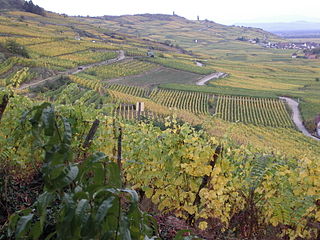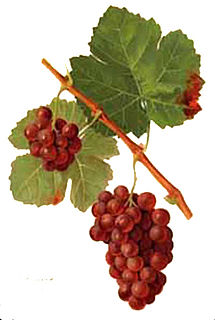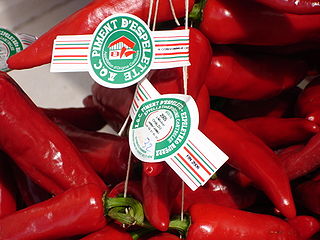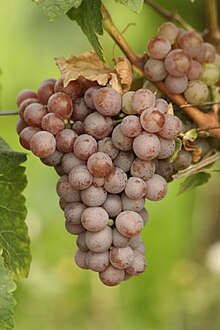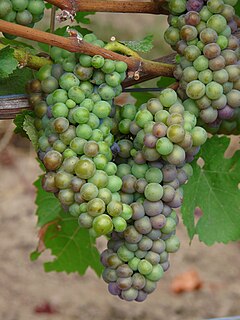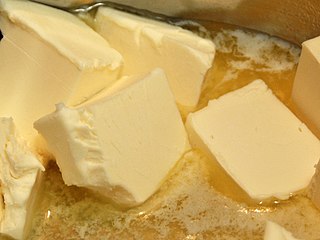
Pinot blanc is a white wine grape. It is a point genetic mutation of Pinot noir. Pinot noir is genetically unstable and will occasionally experience a point mutation in which a vine bears all black fruit except for one cane which produces white fruit.

Pinot gris, pinot grigio or Grauburgunder is a white wine grape variety of the species Vitis vinifera. Thought to be a mutant clone of the pinot noir variety, it normally has a grayish-blue fruit, accounting for its name but the grapes can have a brownish pink to black and even white appearance. The word pinot could have been given to it because the grapes grow in small pine cone-shaped clusters. The wines produced from this grape also vary in color from a deep golden yellow to copper and even a light shade of pink, and it is one of the more popular grapes for skin-contact wine.
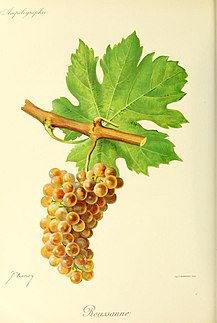
Roussanne is a white wine grape grown originally in the Rhône wine region in France, where it is often blended with Marsanne. It is the only other white variety, besides Marsanne, allowed in the northern Rhône appellations of Crozes-Hermitage AOC, Hermitage AOC and Saint-Joseph AOC. In the southern Rhône appellation of Châteauneuf-du-Pape AOC it is one of six white grapes allowed, where it may be blended into red wines. Roussanne is also planted in various wine-growing regions of the New World, such as California, Washington, Texas and Australia as well as European regions such as Crete, Tuscany and Spain.
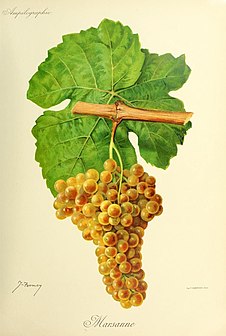
Marsanne is a white wine grape, most commonly found in the Northern Rhône region. It is often blended with Roussanne. In Savoie the grape is known as grosse roussette. Outside France it is also grown in Switzerland, Spain, Australia, New Zealand, Canada and the United States.

Grüner Veltliner is a white wine grape variety grown primarily in Austria, Hungary, Slovakia, and the Czech Republic. The leaves of the grape vine are five-lobed with bunches that are long but compact, and deep green grapes that ripen in mid-late October in the Northern Hemisphere.

Vin jaune is a special and characteristic type of white wine made in the Jura region in eastern France. It is similar to dry fino Sherry and gets its character from being matured in a barrel under a film of yeast, known as the voile, on the wine's surface. Vin jaune shares many similarities with Sherry, including some aromas, but unlike Sherry, it is not a fortified wine. The wine is made from the Savagnin grape, with some of the most premium examples coming from the marl based vineyards in the Château-Chalon AOC. In other French wine regions, there has been experimentation in producing similar style wines from Chardonnay and other local grape varieties using cultured yeast such as the vin de voile wine produced in the Gaillac.
Arbois or Arbois Blanc is a white French wine grape variety planted primarily in the Loire regions. Despite being a minor grape, in the late 20th century it was the third most widely planted grape variety in the Loir-et-Cher département which includes the winemaking areas of Cheverny, Cour-Cheverny, Montrichard, Oisly, Saint-Romain-sur-Cher, Valençay as well as vineyards that make wines under the Touraine AOC, Cremant de Loire AOC and Vin de Pays du Loir et Cher. By 2004 acreage had steadily declined to around 750 acres. It is still a permitted grape variety in the Appellation d'origine contrôlée (AOC) regions of Cheverny AOC, Valençay AOC and Vouvray AOC.

Sylvaner or Silvaner is a variety of white wine grape grown primarily in Alsace and Germany, where its official name is Grüner Silvaner. While the Alsatian versions have primarily been considered simpler wines, it was recently (2006) included among the varieties that can be used to produce Alsace Grand Cru wine together with the four 'noble grapes' of Alsace, although only in one vineyard, Zotzenberg.

Jura wine is French wine produced in the Jura département. Located between Burgundy and Switzerland, this cool climate wine region produces wines with some similarity to Burgundy and Swiss wine. Jura wines are distinctive and unusual wines, the most famous being vin jaune, which is made by a similar process to Sherry, developing under a flor-like strain of yeast. This is made from the local Savagnin grape variety. Other grape varieties include Poulsard, Trousseau, and Chardonnay. Other wine styles found in Jura includes a vin de paille made from Chardonnay, Poulsard and Savagnin, a sparkling Crémant du Jura made from slightly unripe Chardonnay grapes, and a vin de liqueur known as Macvin du Jura made by adding marc to halt fermentation. The French chemist Louis Pasteur was born and raised in the Jura region and owned a vineyard near Arbois that is still producing wine today under the management of Jura's largest wine firms: Henri-Maire.
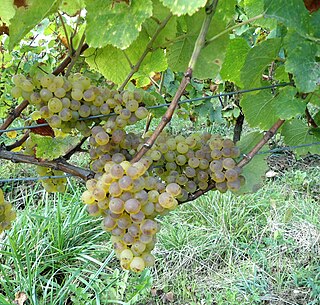
Savagnin or Savagnin blanc is a variety of white wine grape with green-skinned berries. It is mostly grown in the Jura region of France, where it is made into Savagnin wine or the famous vin jaune and vin de paille.

French wine is produced all throughout France, in quantities between 50 and 60 million hectolitres per year, or 7–8 billion bottles. France is one of the largest wine producers in the world. French wine traces its history to the 6th century BC, with many of France's regions dating their wine-making history to Roman times. The wines produced range from expensive wines sold internationally to modest wines usually only seen within France such as the Margnat wines were during the post war period.

Crémant d'Alsace is an Appellation d'Origine Contrôlée for sparkling wines made in the Alsace wine region of France. Produced since 1900, the Crémant d'Alsace AOC was recognized in 1976 by the INAO and the designation Crémant regulated by the European Parliament in 1996.
Klevner or Clevner is a synonym for various grape varieties and wines, and is primarily used in German-speaking wine regions. The word derives from the Swiss version of the name of the Northern Italian town Chiavenna, Kleven, situated at the north end of Lake Como. Swiss mercenaries brought grapevines from that region back home across the Alps at the beginning of the 16th Century.
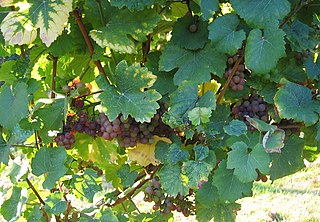
Savagnin Rose or Roter Traminer is a variety of wine grape. It has a pink, reddish or brownish red skin colour, but is counted as a "white wine grape" since it does not have the deep purple/blue/black colour of "red wine grapes".
Braquet is a red French wine grape variety grown predominantly in the Provence region of southeastern France, particularly in the Bellet Appellation d'origine contrôlée (AOC) where it is as both a blending and varietal grape in still and rosé wines. Also known as Brachet, the vine produces naturally low yields and light bodied wines that are delicately perfumed. Recent thought among ampelographers is that Braquet is not related to the more aromatic Italian wine grape of the Piedmont region known as Brachetto.

Moselle wine is produced in three countries along the Moselle river: France, Luxembourg and Germany. Moselle wines are mainly white and are made in some of the coldest climates used for commercial winemaking.
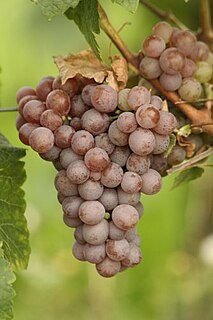
Musqué is a French term applied to certain varieties or clones of grapes used for making wine. The term means both perfumed ("musky") and Muscat-like, and indicates that the variety or clone is highly aromatic. The term musqué is usually suffixed to the name of certain grape varieties to indicate a clone with musqué properties, e.g. "Chardonnay musqué" or "Sauvignon blanc musqué". Such clones have arisen through mutation of a regular ("non-musqué") clone of the variety, and such mutations have been recorded for several different grape varieties.

The wine region of Alsace produces wines under three different Appellations d'Origine Contrôlées (AOCs): Alsace AOC for white, rosé and red wines, Alsace Grand Cru AOC for white wines from certain classified vineyards and Crémant d'Alsace AOC for sparkling wines. This region is the only French wine region allowed to label its wines based on variety.

